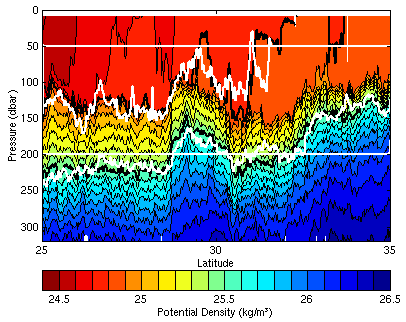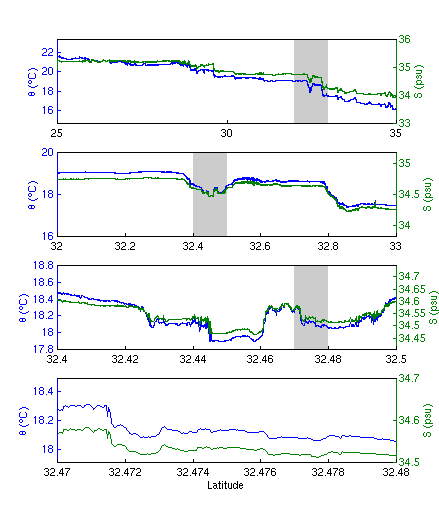

|
Compensation |
| Raffaele Ferrari |
The density of seawater is determined by two properties: temperature and salinity. Thus temperature and salinity may vary along a surface of constant density. This variability, sometimes called spiciness, is a result of air-sea fluxes, turbulent mixing, and advection. The goal of this exploratory experiment is to observe spiciness in the upper ocean, including the mixed layer, at horizontal scales of 10 m to 1000 km.

|
| Figure 1. A summary of the Spice Experiment data. The potential density section along 140°W, as measured by a sawtooth tow has 3 km resolution. Finer horizontal resolution down to 4 m is obtained by towing along isobars or isopycnals. The straight white lines are isobaric tows at 50 and 200 dbar. The heavy black lines are isopycnals 24.8 and 25.5 kg/m³ as measured during the sawtooth tow. The jagged white lines are tows along these isopycnals. The difference between the black and white lines is due to oceanic variability, that is, the isopycnals moved during the time between surveys. |
Specific objectives of the Spice Experiment are: (1) to quantify the density ratio in the mixed layer and seasonal thermocline, (2) to find if salinity varies on shorter horizontal scales than does temperature, (3) to confirm that there is more spiciness in the mixed layer than in the seasonal thermocline, and (4) to find where and over what length scales the reduction in spiciness occurs. These objectives are being addressed using data from a cruise in the eastern North Pacific between 25°N and 35°N conducted 24 January - 20 February 1997 (Figure 1). Measurements were made using a SeaSoar equipped with a CTD and fluorometer. The SeaSoar was towed in three patterns: (1) sawtooth patterns between 5 and 320 dbar to resolve horizontal length scales down to 3 km, (2) level tows at 50 dbar in the mixed layer and 200 dbar in the seasonal thermocline, and (3) tows following an isopycnal that went from beneath the mixed layer to outcropping (24.8 kg/m³), and following an isopycnal in the seasonal thermocline (25.5 kg/m³). Our newly designed control system worked better than anticipated and the SeaSoar followed an isobar to within a root-mean-square deviation of 0.3 dbar, and an isopycnal to within 0.02 kg/m³. The level and isopycnal tows resolved horizontal scales down to 4 m.

|
| Figure 2. Potential temperature and salinity at 50 dbar. The top panel shows temperature and salinity over the entire tow from 25°N to 35°N. Each succeeding panel is a magnification by a factor of ten of the shaded region in the panel above. Note the change in scale on the horizontal axis of each panel; the bottom panel spans 0.01° in latitude (roughly 1 km). The vertical axes are scaled by the thermal and haline expansion coefficients so that equal excursions of temperature and salinity imply identical effects on density. Note that nearly every feature in temperature is mirrored by one in salinity at all scales. Temperature and salinity structure compensate to produce very small density gradients. |
The first objective of the Spice Experiment is to quantify the horizontal density ratio in the mixed layer. The density ratio is defined as the ratio of the effect of a temperature change on density divided by the effect of a salinity change. The isobaric tow at 50 dbar in the mixed layer is ideal to address this first objective (Figure 2). Somewhat surprisingly, temperature and salinity nearly compensate in their effect on density at all scales observed from 1000 km to 10 m. In other words, the density ratio is rougly one on all horizontal scales. The implication is that horizontal mixing in the ocean works to eliminate horizontal density, but not spiciness, gradients. A parameterization of diffusivity in terms of the density gradient is suggested.
Ferrari, R., and W. R. Young, 1997: On the development of thermohaline
correlations as a result of nonlinear diffusive parameterizations, J.
Mar. Res., 55, 1069--1101.
Rudnick, D. L. and R. Ferrari, 1999: Compensation of horizontal temperature and salinity gradients in the ocean mixed layer. Science, 283, 526-529.
Ferrari, R. and D. L. Rudnick, 2000: Thermohaline variability in the upper
ocean. J. Geophys. Res., 105, 16,857-16,883.
Ferrari, R., D.L. Rudnick, W. R. Young, and F. Paparella, 2001: The temperature-salinity
relationship of the surface mixed-layer. Proceedings of the 'Aha Huliko'a
Winter Workshop, Honolulu, Hawaii, 95-104.
Ferrari, R. and F. Paparella, 2003: Thermohaline alignment and compensation
in the ocean mixed layer, J. Phys. Oceanogr., in press.
 Raffaele Ferrari's Home Page
Raffaele Ferrari's Home Page